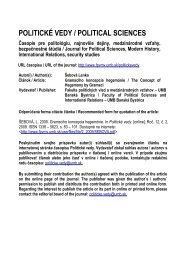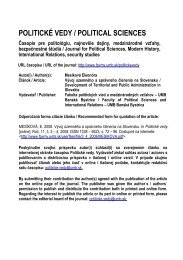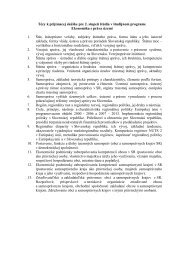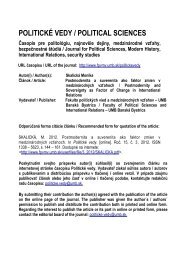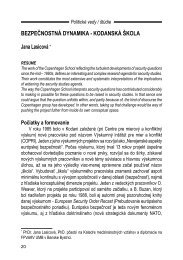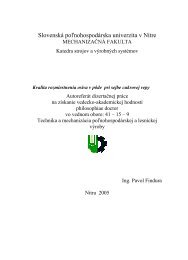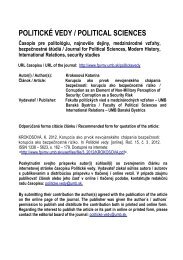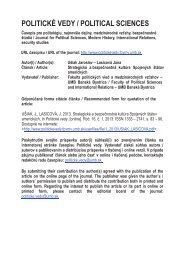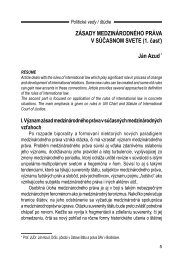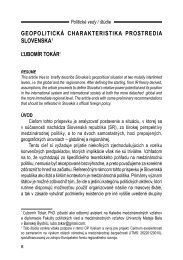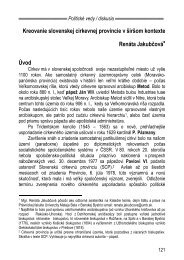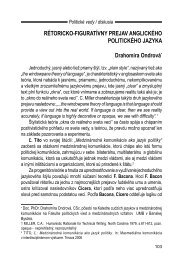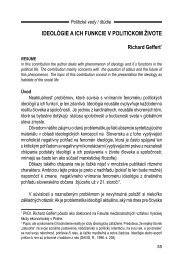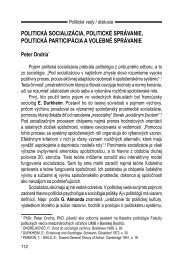MRAVNÃ VÃCHOVA V Å KOLÃCH NA SLOVENSKU A V ZAHRANI ÄÃ
MRAVNÃ VÃCHOVA V Å KOLÃCH NA SLOVENSKU A V ZAHRANI ÄÃ
MRAVNÃ VÃCHOVA V Å KOLÃCH NA SLOVENSKU A V ZAHRANI ÄÃ
You also want an ePaper? Increase the reach of your titles
YUMPU automatically turns print PDFs into web optimized ePapers that Google loves.
Specifically, the goal is to offer students a systematic opportunity to experience the effects of prosocial<br />
behaviours in their interpersonal and professional relationships. The underlying hypothesis is that this<br />
experience can enhance and optimise the quality of these relationships to the point of making it more<br />
improbable for conflicts, disputes, enmities and hostilities to arise.<br />
To this end, the practical classes are held to tutor students in planning their own Prosocial Laboratory.<br />
Personal Domains<br />
Action in this first domain is real, that is, students must design, implement and experience an action<br />
plan consisting of executing a certain number of prosocial actions (ranging between five and ten, duly<br />
chosen from a list or Table-Inventory (see Appendix A) from a list of twenty to forty prosocial<br />
behaviours that were previously generated by the student him/herself, in accordance with the ten<br />
categories or classes of prosocial actions from the UNIPRO Model: physical service, help, giving and<br />
sharing, etc. (see Appendix B).<br />
The recipients can be individuals or groups, always within the domain of the student’s personal<br />
relationships, and they are generally family, partner, friends, strangers or volunteers.<br />
Some variables for choosing the target behaviours to be implemented are:<br />
1. It must at least be an action aimed at someone with whom there is a difficult relationship, either<br />
because there is no spontaneous mutual liking; or because there has been some unpleasant<br />
experience with this person; or because there is a distancing, either intentional or not; or because<br />
there is a latent conflict.<br />
2. An action to be performed in apparently difficult conditions in terms of the actor’s mental state,<br />
for example, on a day or at a time when he or she is feeling low. Through this modality we strive<br />
to investigate the possible beneficial consequences of a prosocial action on the actor’s mindset.<br />
3. And that another action, amongst the five remaining, be proposed, presented, motivated for<br />
another person to perform to a third person. That is, the operator of the action does not directly<br />
perform the action but promotes and stimulates another operator to perform it, but always<br />
promoting that the other person’s initiative and creativity governs this action.<br />
The design of the action plan includes an implementation calendar and a registration or file card (see<br />
Appendix B) which contains the following sections:<br />
• Background of the action (perceived need or indication).<br />
• Description of the action.<br />
• Consequences for the recipient (results, verbal or emotional reactions, etc.).<br />
• Consequences for the actor (experiences, cognitions, feelings experienced).<br />
• Observations (interpretations, comments).<br />
CONCLUSIONS<br />
These types of practices have been implemented since 2000. Around eight hundred students have<br />
participated in them (around 130 each academic year). Each of them has presented a report about the<br />
activities, with a total of 3,900 prosocial activities having been performed.<br />
We are working to develop a synthesis of the results using a PAR (Participation-Action-Research)<br />
methodology that would enable us to identify the number of actions, their length, frequency, cost,<br />
types of reactions in the recipients, and the consequences for the actor, according to categories<br />
identified with input from the students themselves.<br />
The preliminary estimates present surprisingly positive results. We have identified around 15% of the<br />
reports as exemplary, with very interesting personal styles. Around 90% of the reports claim that their<br />
authors have been convinced (compared to the initial reservations expressed in the theoretical classes)<br />
163



